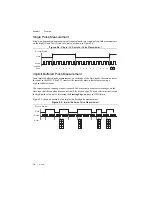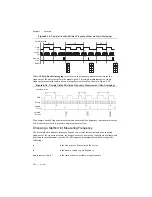
© National Instruments
|
5-19
NI cDAQ-9132/9133/9134/9135/9136/9137 User Manual
Position Measurement
You can use the counters to perform position measurements with quadrature encoders or
two-pulse encoders. You can measure angular position with X1, X2, and X4 angular encoders.
Linear position can be measured with two-pulse encoders. You can choose to do either a single
point (on-demand) position measurement or a buffered (sample clock) position measurement.
You must arm a counter to begin position measurements.
Refer to the following sections for more information about the cDAQ controller position
measurement options:
•
Measurements Using Quadrature Encoders
•
Measurements Using Two Pulse Encoders
•
Buffered (Sample Clock) Position Measurement
Measurements Using Quadrature Encoders
The counters can perform measurements of quadrature encoders that use X1, X2, or X4
encoding. A quadrature encoder can have up to three channels—channels A, B, and Z.
•
X1 Encoding
—When channel A leads channel B in a quadrature cycle, the counter
increments. When channel B leads channel A in a quadrature cycle, the counter
decrements. The amount of increments and decrements per cycle depends on the type of
encoding—X1, X2, or X4.
Figure 5-17 shows a quadrature cycle and the resulting increments and decrements for X1
encoding. When channel A leads channel B, the increment occurs on the rising edge of
channel A. When channel B leads channel A, the decrement occurs on the falling edge of
channel A.
Figure 5-17.
X1 Encoding
•
X2 Encoding
—The same behavior holds for X2 encoding except the counter increments
or decrements on each edge of channel A, depending on which channel leads the other.
Each cycle results in two increments or decrements, as shown in Figure 5-18.
Figure 5-18.
X2 Encoding
Ch A
Ch B
Co
u
nter V
a
l
u
e
7
7
6
5
5
6
Ch A
Ch B
Co
u
nter V
a
l
u
e 5
6
8
9
7
5
6
8
9
7
















































